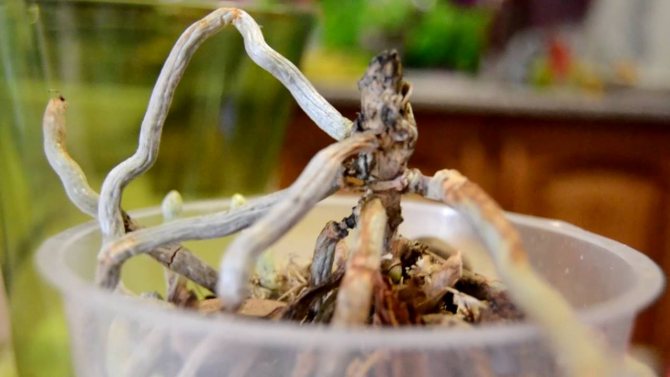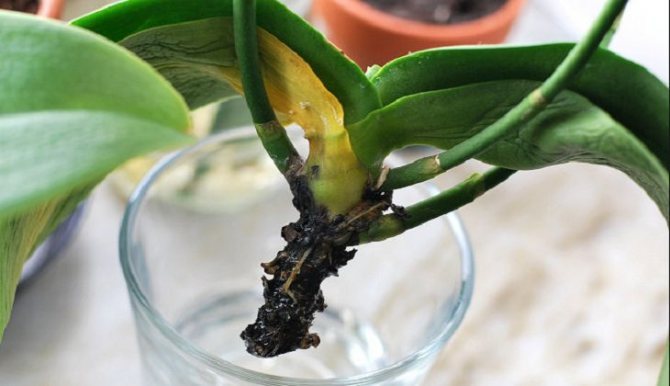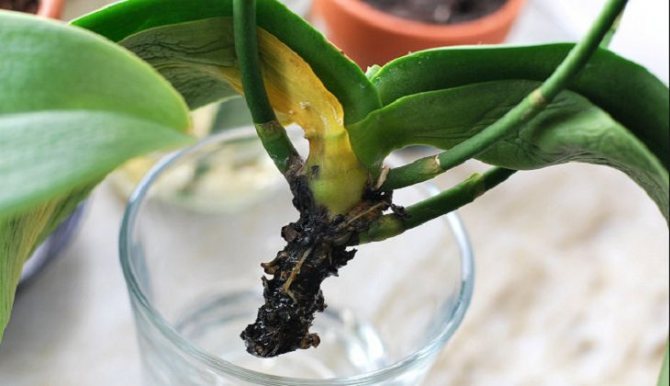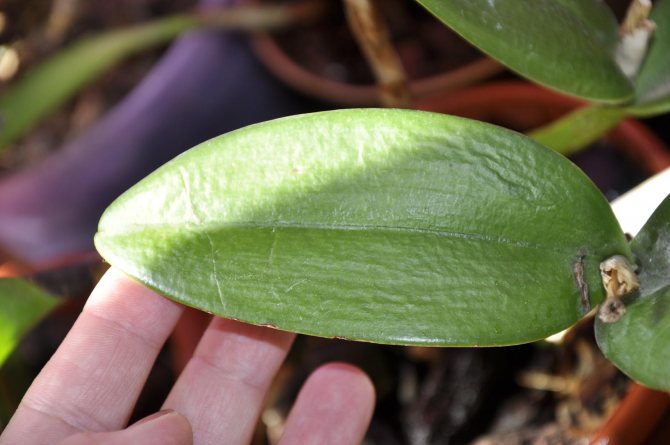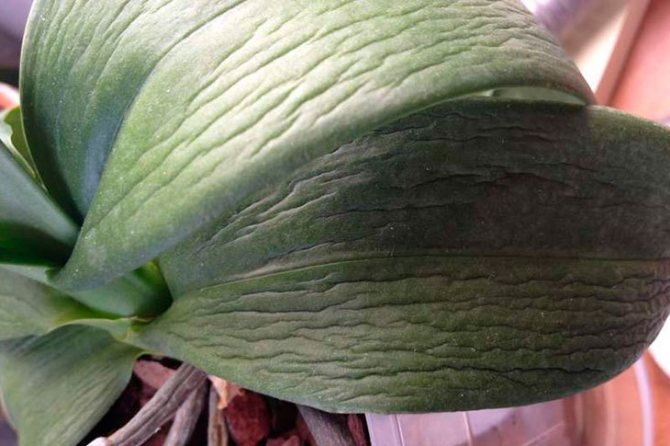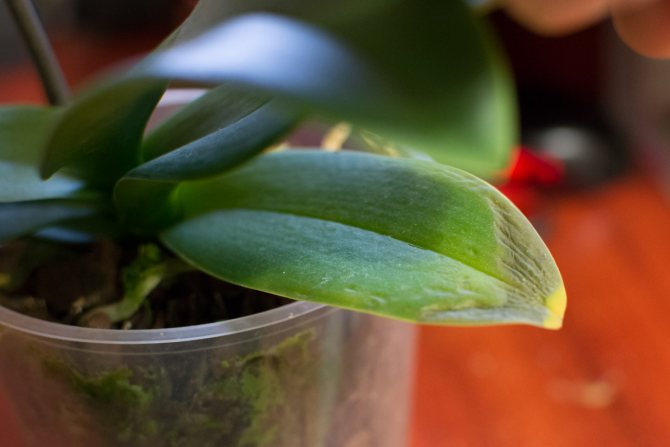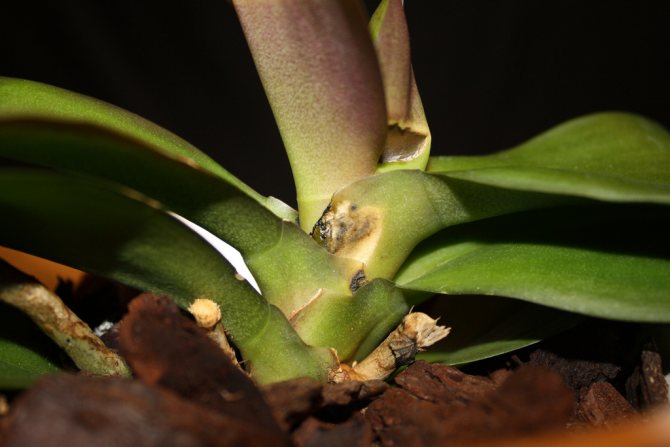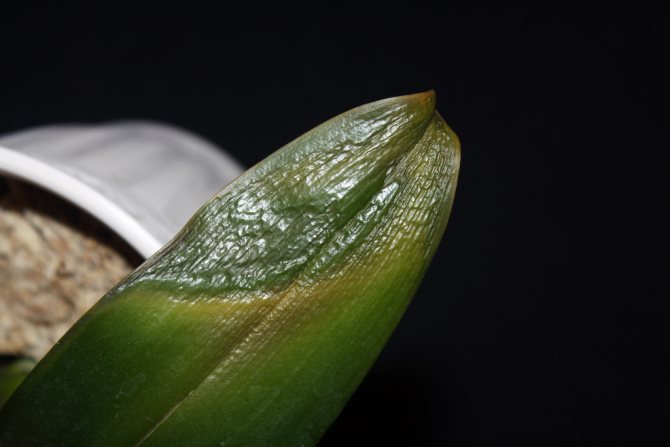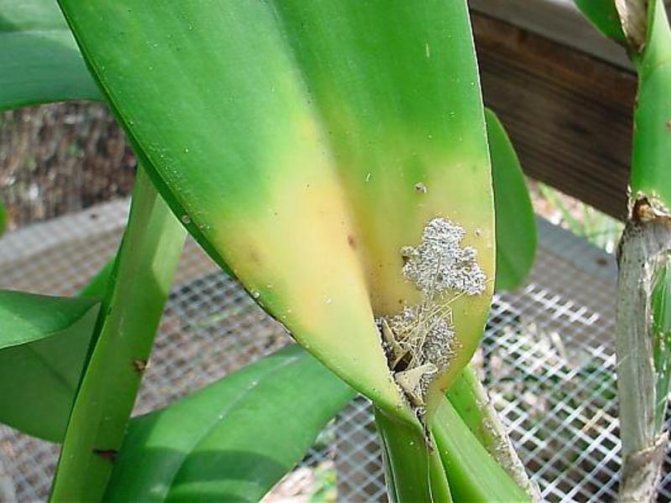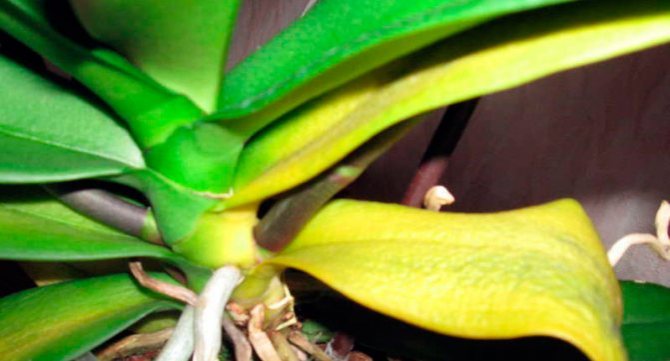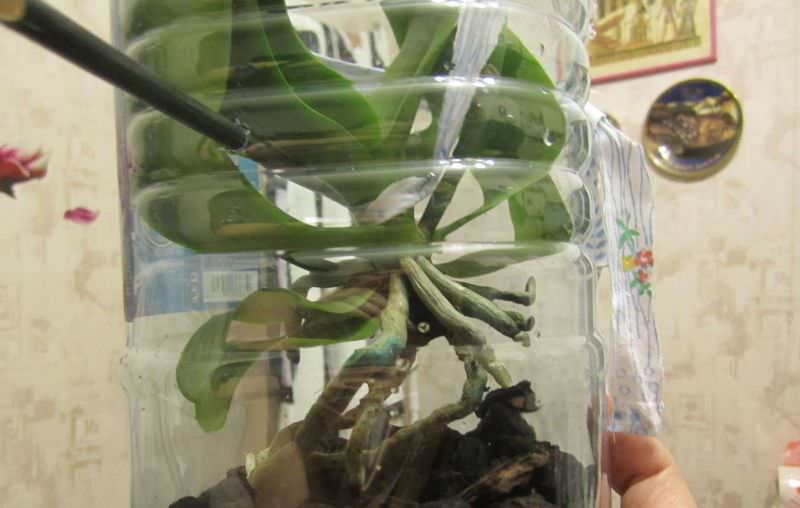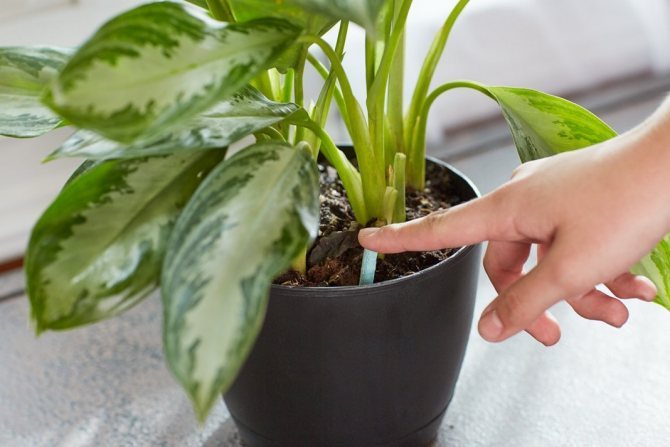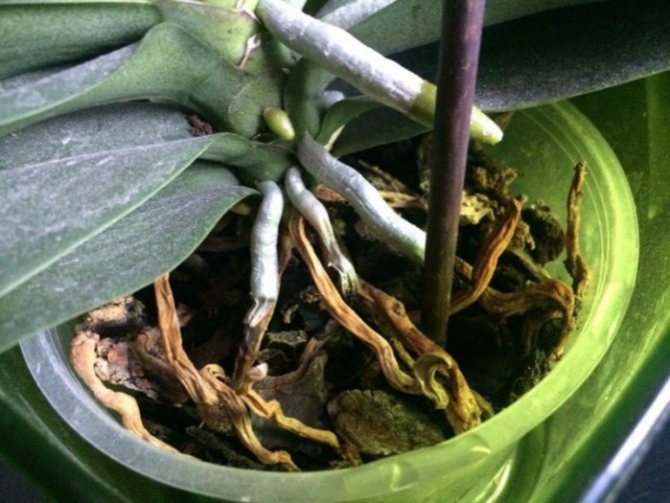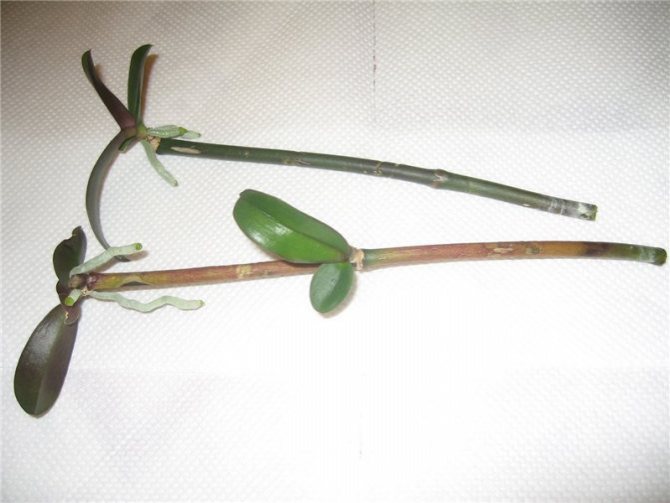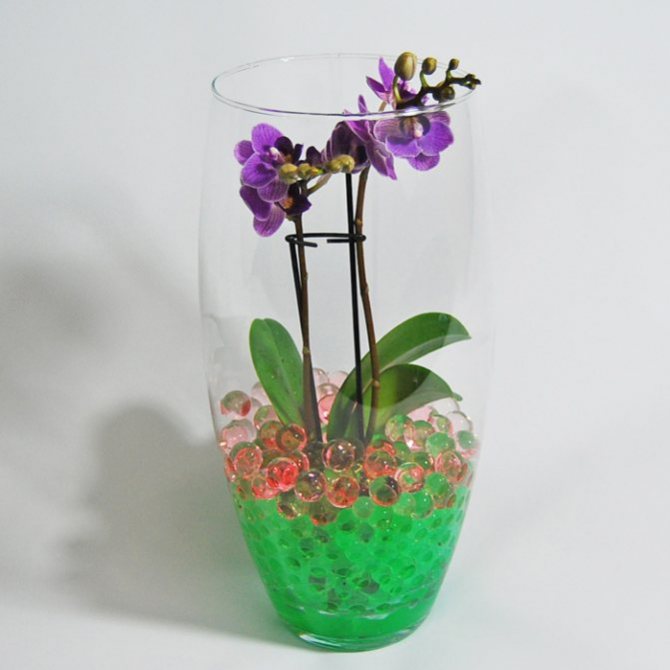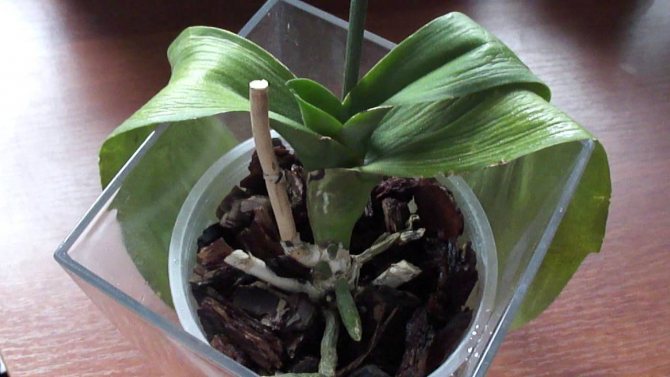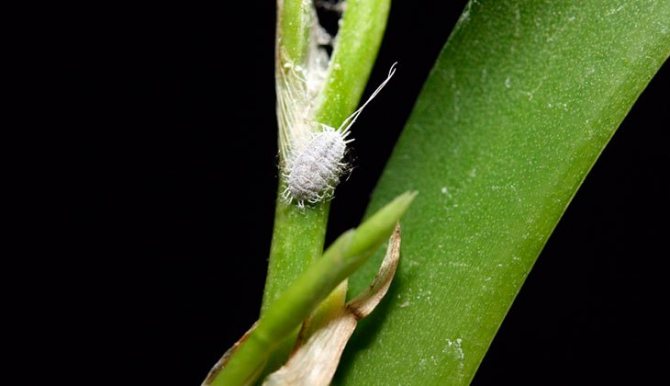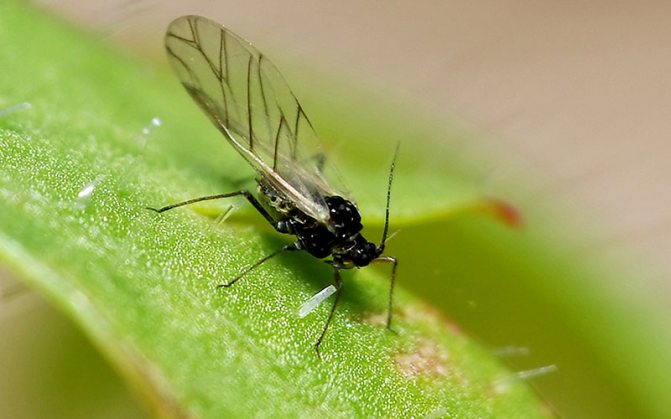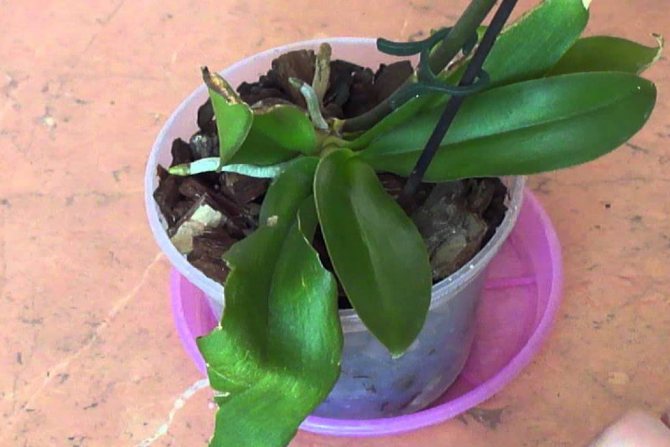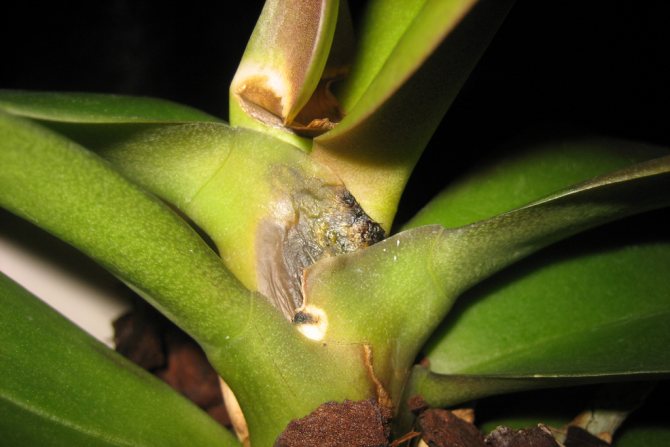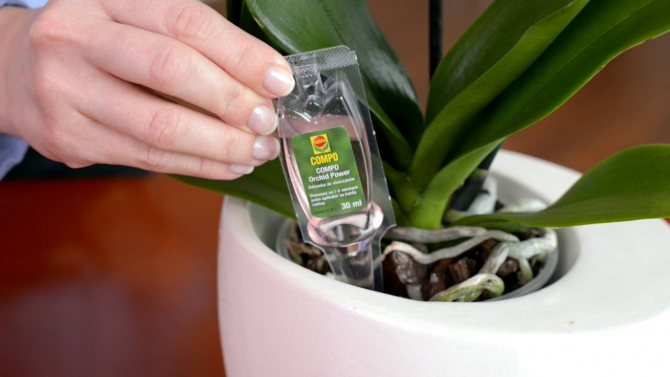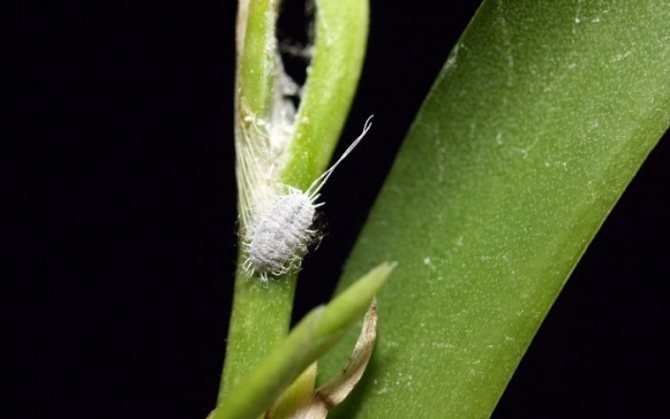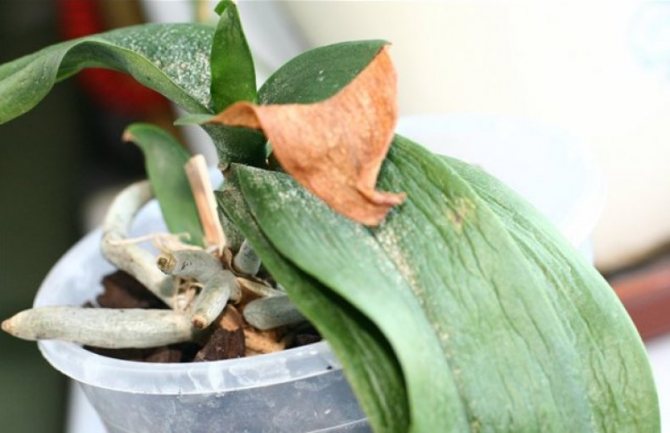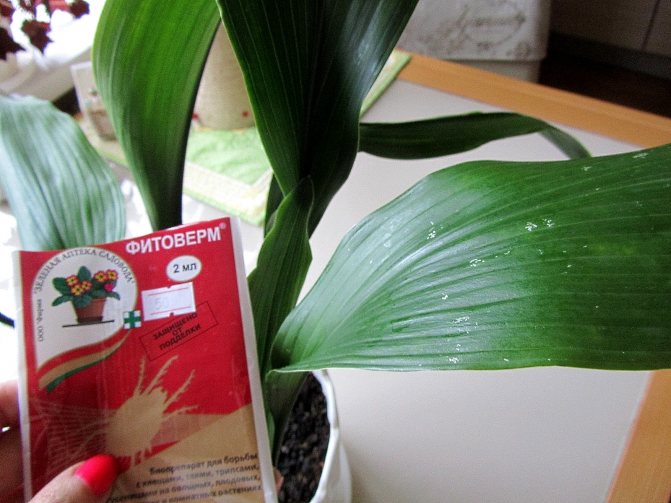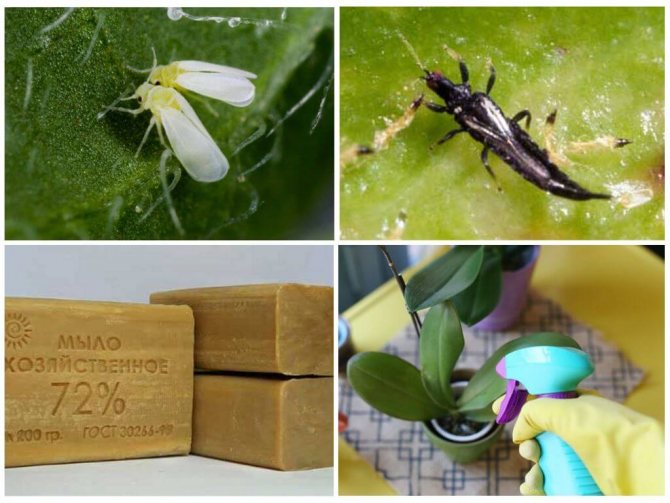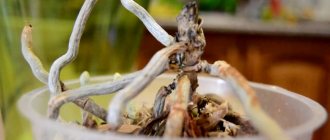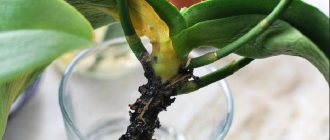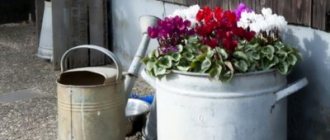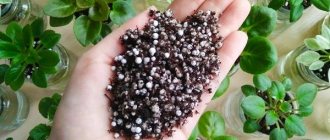Below in the article we will tell you how to save an orchid without roots and with sluggish leaves.
Signs of orchid damage
Rotting of the root system develops slowly, so beginners do not immediately detect manifestations. A diseased orchid stops the formation of new leaves. The plates lose their turgor, turn yellow from the side of the neck, the formation of spots is observed. In advanced cases, the surface of the greenery is covered with a sticky mucous bacterial layer.
If the roots have rotted, then the phalaenopsis does not hold well in the pot: the plant hangs in the substrate or falls out of the container.
In case of problems with the orchid, the buds actively crumble, wither. The peduncle freezes, slows down development. The appearance of "babies" is a sign of the impending death of the mother bush.
Phalaenopsis is taken out of the pot, the system is carefully examined. The healthy root of the plant is covered with a protective layer of velamen. Under the influence of ultraviolet light, good organs acquire a grayish-green tint, and those hidden in the substrate - a dirty yellow. When pressed, moisture is not released from the tissues, voids are not felt, the upper tier does not peel off. If you cut a piece into pieces, then there will be a black center inside.
Dense substrate
Air must always circulate between the roots of the orchid. This is a prerequisite for a flower, in addition to a moist environment in a pot. If the leaves of the phalaenopsis are shriveled, the cause may be a dense substrate.
The substrate for the orchid should be loose.
The loose substrate provides ventilation of the roots, they remain healthy, do not rot, excess moisture is easily removed. If the orchid withers, then these conditions are not met.
The cause of leaf wilting is eliminated by completely replacing the substrate. Properly processed, quality bark easily absorbs water, filtering it through its pores.
The severity of the problem
The turgor pressure of the leaf plates disappears for various reasons. The leaves fade, become soft, lethargic and wrinkled. The rich green color darkens, over time, flabby leaf plates turn yellow and fall off. If you do not help the orchid, then soon it will completely wither.
The turgor pressure of the leaf plates disappears with improper care
You can save an exotic flower if you pay attention to its condition in a timely manner. The leaf plates are flabby and wrinkled under the influence of the environment. Such a flower reaction is possible with improper care or after transplantation.
At an advanced stage, it will be extremely difficult to reanimate the plant, since irreversible processes of decomposition of the root system occur. If on a flowering or in a relatively dormant orchid the leaves have wilted, shriveled and wither, reconsider the peculiarities of caring for an exotic culture.
How does the problem manifest itself and what does it threaten?
ATTENTION: Normal, healthy leaves have a rich green color. They are firm, firm and smooth. The diseased leaf first begins to turn yellow before it dries. This can manifest itself immediately in a large volume, or it can begin with minor changes.
The leaf begins to dry from the tips, forming an ugly, brittle crust... The color of such a leaf is either light sandy or darker brown. But it also happens that the process first affects the middle of the sheet, resembling burns or streaks.
Any deterioration in the appearance of the plant is in itself a bad signal. Dry leaves are dangerous primarily because the problem with the flower can affect the health of neighboring plants. Also, many do not attach importance to the drying leaf, which means that illness or unfavorable conditions will destroy the flower - the time for recovery will be lost.
Orchid leaves can dry out in a few hours, so do not delay plant rehabilitation.
Causes of damage to the root collar
Novice flower growers do not know why orchid roots rot. All phalaenopsis diseases are associated with care errors. Hybrids that are resistant to apartment conditions do not withstand frequent violations of agricultural technology. The existing problems are divided into several large groups.
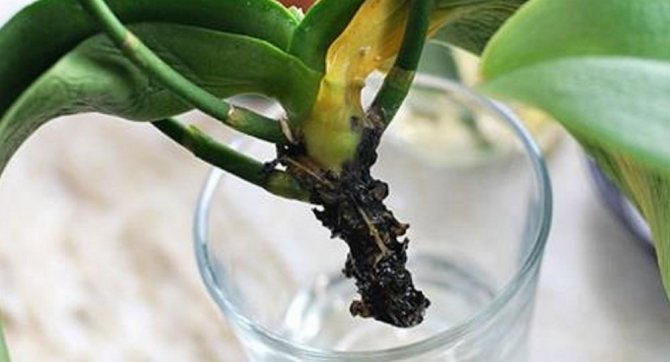
Excessive watering
The orchid loves a moist substrate, but does not tolerate constant stagnation of water. Regular swamp causes decay of the roots, neck and foliage of the plant. At low temperatures, agricultural technology slips stimulate the appearance of fungal diseases. Yellowed bottom plates warn of a problem. The wet growing point is the source of the spread of disease.
Lack of proper lighting
The photosynthesis of a plant occurs under the influence of sunlight. Due to the lack of ultraviolet radiation, the orchid slows down life processes. During this period, phalaenopsis consumes less water, so excess moisture remains in the substrate. If you do not provide additional lighting, then rotting of the roots and neck will begin.
Sunburn is just as dangerous to an orchid as a lack of light. Plants do not like bright directional ultraviolet light after 12 days on the southern windowsill. The result of the error is yellow spots with a black border on the leaves and flowers. If the affected areas are wet, then putrefactive processes increase the volume of wounds. In a neglected state, the spots go to the neck.
Excess watering
If the orchid leaves wither, it may be over-watered. In this case, the phalaenopsis withers completely: the roots rot, and healthy ones become insufficient to provide nutrition for the entire plant.
You can cure the plant, this will require a number of activities:
- Remove the plant from the substrate.
- Examine each root and remove rotten to healthy tissue.
- Treat the sections with charcoal, cinnamon or powder fungicide.
- Leave the roots to dry for 10 hours.
- Prepare a new dry, loose substrate.
- Transplant the plant.
It is necessary to water the plant when the roots have acquired a bluish-gray tint. If they are bright green, then there is enough moisture in them to feed the flower. If the leaves wrinkle, the orchid is left without watering for several days.
Practical advice on care after saving a flower
A reanimated orchid needs to be properly cared for. The restored root system goes through the process of adaptation to new conditions, improves nutrition. Recommendations:
- Carefully control the moisture content of the soil, exclude the possibility of root rot.
- Place the container with the convalescent orchid in a well-lit place, protect from direct sunlight. Delicate young leaves can easily burn.
- Maintain the temperature that is optimal for your orchid variety.
- Ventilate the area regularly, try to avoid drafts.
- Adjust your care with the onset of winter - arrange backlighting, ensure sufficient humidity and temperature.
Competent actions will allow you to preserve your orchid, improve its health, and analysis of mistakes will help you avoid diseases in the future.The plant can be saved even when all the roots have disappeared or the leaves have fallen off.
Causes of wilting leaves
Orchid leaves age and die over time. Don't delete them. The plant itself will get rid of yellowed and dried leaves when it takes all the nutrients from them.
For reference! The processes of wilting, aging and cell destruction are accompanied by a decrease in turgor. Turgor is a stressed state of cells caused by intracellular hydrostatic pressure.
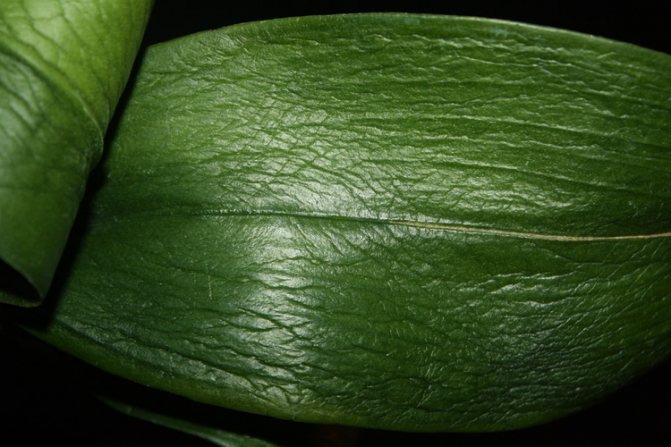

Decreased turgor of orchid leaves
If all the leaves of the orchid have lost their elasticity, they are looking for the reason:
- Hot air flow from the battery. As a result, moisture quickly evaporates through the leaves and pseudobulb, leading to wilting. During the heating season, the orchid is rearranged from the windowsill to avoid overheating;
- Direct sunlight. In summer, the south-facing windows are closed with blinds. Otherwise, the plant may get burned and die;
Advice! After winter, the orchid is gradually accustomed to the spring-summer sun. In any case, use blinds from the hot sun.
- Waterlogging of the soil. The result is a lack of air and wilting of leaves;
- Insufficient watering. Orchids are tropical plants. They love warmth and moisture;
For reference! The watering schedule is individual for each plant.
- Old soil. Over time, the substrate cakes and compresses, which prevents the plant from getting enough moisture and "breathing";
- Lack of space in the flowerpot. When there are too many roots in the pot, the plant does not receive enough oxygen and nutrients. Leaves turn yellow and wither;
- High concentration of fertilizers. The tips of the plant turn black or red. Mineral and salt fertilizers dry out the root system;
- Pests:
- root worm - feeds on the juice of the roots;
- podura or springtails. They live in waterlogged soil - on the surface, in pallets;
- Root damage:
- viral,
- bacterial,
- fungal;
- Lack of calcium and phosphorus;
- Hypothermia;
- Stress;
- Vascular mycosis, root rot. Leaves wither and wrinkle quickly. It is difficult to save an orchid.
In case of viral damage, the roots are covered with small specks or stripes. It is not treated.
Bacterial causes ulcers on the roots with fluid released from them and softening of tissues. The affected parts are removed.
Fungal are characterized by a pink or yellow bloom on the roots. Occurs when waterlogged. The infected parts are removed, the sections are treated with crushed coal, cinnamon or ash.
Note! Do not use alcohol-based solutions for slicing.
Signs of dead roots are blackening, crunching and breaking when pressed. The reasons:
- excess or lack of moisture,
- plant age,
- lack of light.
If the roots were damaged during transplantation and were not treated with an antiseptic, bacteria penetrate inside. The plant withers.
Effective resuscitation formulations
Decayed roots on orchids must be carefully trimmed. Treatment with special preparations helps to heal the plant. So that microorganisms do not develop resistance to components, it is necessary to alternate means. Florists recommend changing medicines every 3 procedures.
Antibiotics
Fitolavin is a complex drug that is used to destroy bacterial infections and fungi on an orchid. The agent kills the pathogen, protects the plant for 20 days. To prevent the pests from getting used, you cannot use the antibiotic more than 2 times every 60 days. The affected specimen is soaked in the solution for 30 minutes, the cut points are treated or sprayed from a spray bottle.
Fungicides are formulated to fight fungi. If the plant gradually dies, then a strong drug will help stop decay.
Withering after transplant - how to save
Withering after transplant - how to save? First you need to determine the cause of the wilting of the leaves of the plant, and then choose the appropriate treatment. Let's take a look at the most common problems:
- Insufficient watering. To restore the health of the leaves, you need to normalize it. Monitor the condition of the substrate: when it is completely dry, the plant needs watering by bathing (the flower pot is immersed in warm, settled water for twenty to thirty minutes) or spraying. To restore the elasticity of the leaves, you can use a solution of succinic acid (one tablet of the product is diluted in one liter of water) for watering. This remedy promotes the revitalization of the plant and the growth of vegetative mass. Among the available preparations, sugar syrup can be distinguished (one tablespoon of sugar is diluted in one liter of warm water) for watering. Glucose is very beneficial for the plant. Remember to water it in moderation, as excessive watering will cause root rot. It is also useful for a plant to shower for 20-30 seconds for two to three days daily. The water should be about 35 degrees. After that, you need to limit watering for the next two weeks.
- Excessive watering. It leads to root rot. To normalize the situation, you need to remove the plants from the substrate, inspect the root system, cut and process rotting parts and plant the plant in a new substrate. Detailed instructions for the procedure are described above. In the future, you need to take care of the correct conditions of detention.
- Hypothermia. In this case, it is necessary to inspect the roots and, if they are frostbite or die off, prune with a sharp disinfected device. Further, the cut sites are processed, and the plant is planted in a new substrate. The transplant instructions are similar to those described above in the decay situation.
- Too dense substrate. This leads to root rot due to lack of proper aeration and poor drying. The only solution to the problem is replacing the substrate with inspection and pruning of the affected roots.
- Overheat. First, the plant is rearranged in partial shade, at least for two to three hours. If the overheating is insignificant, the orchid will cope on its own. Literally in two or three hours, it will be possible to notice that the leaves are rising. If not, you will have to reanimate the plant by maintaining a comfortable temperature regime. At the time of resuscitation, watering should be moderate - once every 10 days.
- Excess fertilizer. It is very important to read the instructions for using the top dressing. The fertilizer itself should be suitable for the orchid. Always remember that underfeeding is better than overfeeding a flower. The solution to the problem is a complete rejection of fertilization, a change of soil and normalization of irrigation (water washes out excess substances from the soil mixture).
If you find a problem and carry out processing, guided by one of the above methods, and the leaves still wither, then the plant may need to be rejuvenated. It needs to be cleaned of old parts and the rhizome should be examined again. And also the problem may be hidden in a flower disease. Perhaps the plant needs to be shown to an experienced florist.
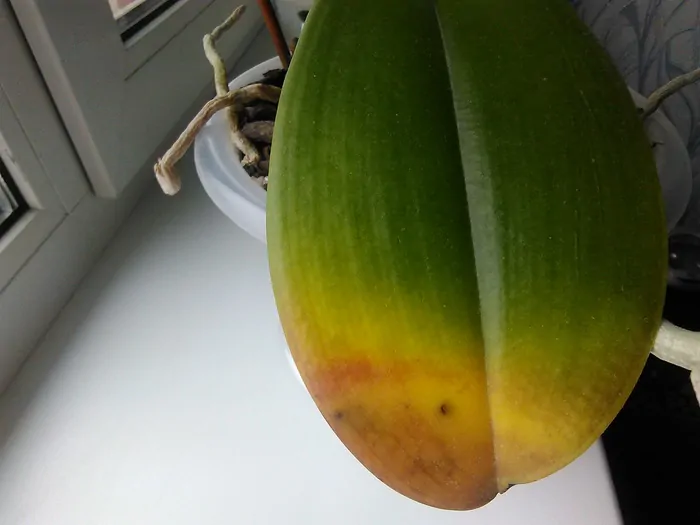

Note! Sometimes an orchid can be affected by a viral disease. In this case, the plant, unfortunately, will have to be destroyed. There is still no effective method of dealing with the virus. The problem lies in the fact that the orchid can get sick with a viral disease, but for a while it seems healthy and even bloom. After the manifestation of the virus, it dies very quickly. The problem can be judged by a change in the color and shape of the plant, the appearance of spots, circles and ulcers. A virus appears due to watering with poor-quality water or processing a flower with dirty tools.
Methods for building new roots using water
A simple way is to reanimate orchids in water, where a well-prepared solution will play the main role.
It will require pre-boiled water at room temperature, activated carbon, any stimulant for root formation. In order for the resuscitation of the Phalaenopsis orchid in water to be successful, before starting work, it is necessary to wait a few hours, putting the plant in the shade, so that the cut is slightly tightened. After it dries, you need to dilute the root former according to the instructions in the instructions and immerse the leaves in it for about twenty minutes. Next, pour water into the prepared container, throw activated carbon and only then immerse the plant there. It is preferable to leave the vessel with the flower in a ventilated room with a temperature of 23 to 25 degrees.
Sometimes the leaves need to be wiped off with a cotton swab, after soaking it in sweet water, sugar can help a weakened plant recover faster. It is imperative to monitor the volume of water in the container with the plant and add warm boiled water as needed.
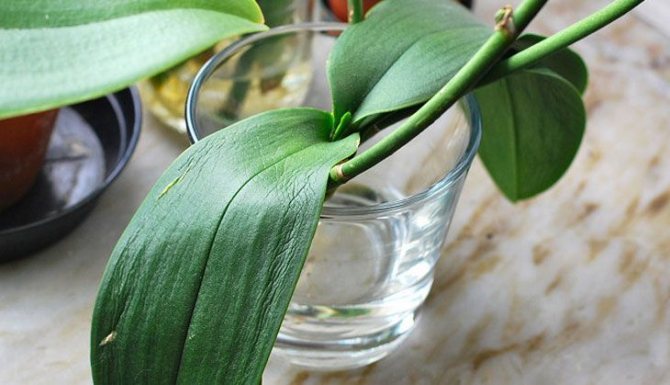

As soon as the roots are about 5 or 7 centimeters long, the flower needs to be transplanted. The whole process will take about two months. In the same way, the orchid baby is reanimated in water.
A more painstaking method is to reanimate an orchid without roots above water, where the plant should not be immersed in liquid.
All rotten and dried roots should be cleaned off. Before removing blackness and cutting off spoiled roots, you need to disinfect scissors or a knife. When the plant is clean, it is worth treating it with a fungicide to prevent rotting. Treat all cut areas without exception with crushed activated carbon. In order for the treated areas to heal, the orchid should be dried and left overnight. Pour clean water into the prepared container so that the distance to the plant is at least 1 centimeter.
Lack of moisture
Orchids are indigenous to the tropics, so they need moist soil combined with warmth for a full life. With the wrong organization of watering, the filling of the leaf cells with moisture is reduced, the leaves wither, become lifeless.
To solve the problem, it is enough to water the orchid. For this:
- prepare a container filled with warm, previously settled water;
- immerse the pot there - the level should be "shoulder-length";
- make a warm shower - water the orchid over the entire leaf area;
- depending on the size, leave the pot in water for 1-3 hours so that the substrate is completely saturated with moisture;
- take out the flower, let the water drain completely, blot the excess on the leaves with a cotton cloth;
- Place the orchid on a warm, well-lit windowsill.
To avoid a repetition of the situation, water the flower as the soil dries.
On a note: the rate of drying of the substrate is affected by its composition, looseness, and the temperature at which the plant is kept.
Prevention measures
To prevent the orchid from rotting, you need proper care. In summer, the plant is kept at a comfortable temperature within + 22-25 ° С, in winter - not lower than +18 ° С. Diffuse lighting should be provided throughout the year. Phalaenopsis is poured with warm water as the substrate dries up, do not allow liquid to enter the growth point. Fertilizers are applied only during the growing season, no more than once a week.
An orchid is a beautiful plant that can be destroyed by care mistakes. Rotting roots is not a sentence, so you need to immediately start treatment. The sooner the resuscitation procedures take place, the easier the exotic flower will return to normal.
What to do to prevent the leaves from withering
Maintaining the health of the plant is important to avoid loss of firmness and parasite infestation of the orchid. To do this, follow the three most important rules of care: keep the flower warm, but do not allow heat, water regularly, but without stagnant moisture, and provide light, but without direct rays.


Save so as not to lose!
Disease manifestations
Proper cultivation of Phalaenopis implies the use of transparent containers, which allow you to determine the onset of putrefactive processes in time and revive or revive the culture.
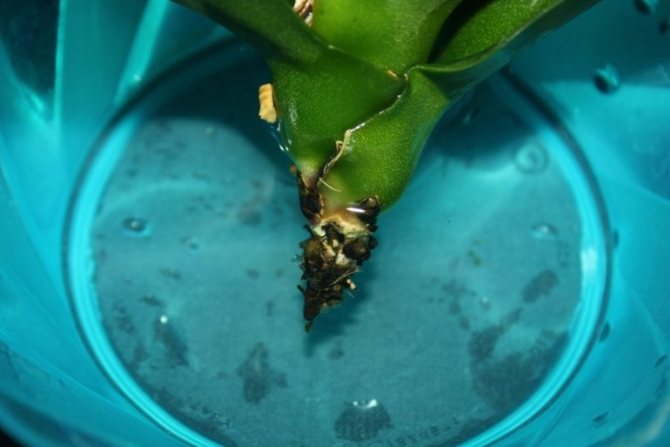

In a healthy state, the roots have an elastic and firm surface, and their shade remains grayish-greenish.
Timely diagnostics will allow you to quickly process a flower, perform a transplant or start a comprehensive restoration.
Among the main manifestations confirming that the orchid began to rot, the following are distinguished:
Preventive measures
To avoid decay, you must follow the rules for caring for orchids. The plant prefers humidity between 70 and 80%. In winter, the air is additionally humidified. Recommended temperature for a flower: 20 to 30 degrees. The light in the room should be dim and diffused. In the autumn and winter months, the flower is illuminated with a phytolamp. Watering should be done so that it is abundant, but not excessive. The substrate should not sour. The earth lump should not dry out. For fertilization, special formulations for orchids are chosen. The flower is transplanted every one to two years.
Now read:
- Restoration and stimulation of orchid flowering with succinic acid
- Ways to stimulate orchids at home
- Choosing cucumbers for open ground according to your preferences
- How to apply the foundation correctly according to the instructions for orchids
About
Leading Researcher of the Laboratory of Vegetable and Berry Crops, Yakutsk Research Institute of Agriculture, Siberian Branch of the Russian Academy of Agricultural Sciences, Republic of Sakha (Yakutia).
Influence on the whole plant
The root is an organ in orchids that is responsible for vital processes. First, the flower is attached by its roots to the substrate, thereby maintaining an upright position. Secondly, the roots absorb moisture and micronutrients from the soil. Thirdly, they, together with leaves, participate in the process of photosynthesis. One can only imagine what will happen to a flower without a root system.
Decay is best cured when the disease is at an early stage. Recognizing the symptoms later, it is unlikely that it will be possible to save the exotic from death.
Important. Use a transparent pot for planting your orchids so that you can regularly check the condition of the root system.
What to do
First, determine the cause of the wilting of the leaves.
They try to gently lift the orchid out of the pot, holding the trunk. The plant must sit firmly in the ground.
If everything is in order, rearrange the flower to another place: remove it from the windowsill and put it away from the window.
Experiment with watering. With a dry surface of the soil, watering is increased, with a wet surface, it is reduced. It is convenient to control the moisture level when the plant is in a transparent pot. The roots have changed color from green to silver - it's time to water.
Several important points about the irrigation regime.
After the end of flowering, the orchid is not watered for a month. In nature, at this time, it spreads seeds through dry air.
Before and during flowering, the plant is watered more often.
The optimum air humidity is 60%. Therefore, the flower needs to be sprayed.
If you overdid it with fertilizers, you need to transplant into a new soil. Be sure to use a special orchid substrate.
For reference! A substrate is a mixture of earth made up of various natural components and their substitutes. For orchids, they buy special soil, or they make it on their own.
After transplanting, the leaves wither due to:
- the wrong pot size,
- a sharp change in the composition of the substrate.
Too large a flowerpot causes acidification of the soil, too small does not allow the roots to "breathe".
An orchid is a living organism. Therefore, she may not like any composition of the soil.
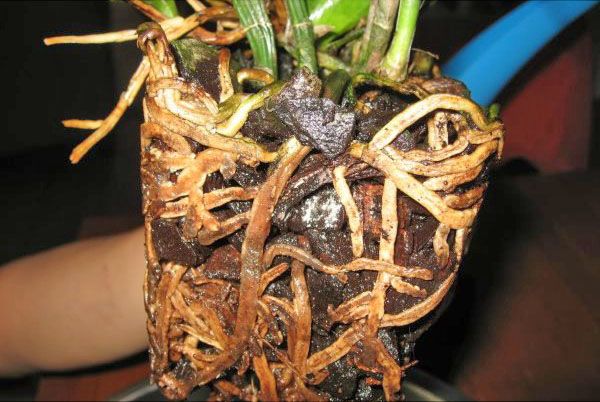

One of the causes of sluggish leaves is root problems.
When the roots are blackened, the watering regime and lighting are adjusted. There should be enough air for the flower.
Sometimes leaf wilting is a response to stress. In the store, the orchid is accustomed to a certain microclimate, and must adapt when changing it. You should wait a little and keep the plant in "quarantine".
If the root system is in order, there is enough moisture and air, the temperature is 25-32 ° C, the soil is fresh and there are no parasites, do the following.
Dilute 3 teaspoons of sugar in a glass of water. The solution is used to wipe the lower parts of the leaves of the plant and leave overnight. Sugar retains moisture. In the morning, the solution is removed from the leaves, allowing the plant to breathe.
Note! The method is used when the leaves of the orchid are not damaged.
Option 1: pruning and processing
So, you pruned the root system and sadly noted the existing losses - about 80%. Then follow the further instructions on the topic: "How to revive an orchid without roots according to option 1".
Moving forward carefully, keeping calm:
- you have already trimmed the roots, now carefully treat the trimmed spots with the disinfectants listed above;
- you still have parts of the roots that are not affected by diseases: place them for a day in one of the strengthening substances, for example, Kornevin's solution;
- after a day, remove the remnants of the roots from the strengthening substance and place them in a new pot with new, correctly laid soil;
- put moss on top of the soil with roots;
- choose a place for your orchid pot with good access to sunlight.
Hypothermia
Orchid is a tropical plant, it is sensitive to indoor temperature conditions. Staying a plant in a draft or at sub-zero temperatures leads to the fact that the leaves wrinkle, their elasticity decreases, they gradually lose all moisture and sink.
In winter, the pot with the plant is not placed on the windowsill if the temperature outside the window reaches -15 ° C. Completely frostbitten leaves are not treated, they are cut off to avoid the formation of rot and its spread to healthy tissues.
It is not necessary to transplant a supercooled flower. If the orchid has soft, sluggish leaves, you can save them as follows:
- Examine the root system, the dead roots are removed, the sections are processed.
- If all the roots are frozen over, they can be grown. For this, the flower is dipped into the solution. In 1 liter of warm water, dilute at choice: 1 ampoule of "Etamon", 1 drop of "Radifarm", 4 drops of "Tsikron" or 2 drops of "Ribav-Extra". The roots will grow back in 1-2 months if you put the plant in clean water, a mixture of bark and moss, in clean moss, or organize a mini-greenhouse, for example, from a plastic bottle.
- Return the flower to dry substrate.
- Provide moderate watering and fertilization.

